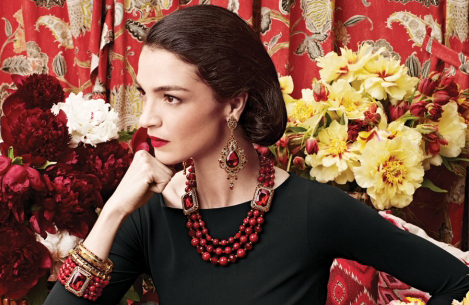Many jewelers long to make a big splash, adorning celebrities with their pieces, selling them in the glitziest emporiums. Not so the man who is so private he goes by his nonetheless distinctive initials – JAR.
For more than 35 years, the Bronx-born Joel Arthur Rosenthal and Pierre Jeannet, his Swiss-born partner, have toiled away under the radar off Paris’ fashionable Place Vendôme in a shop so discreet that the only visible window dressing is a folded pink velvet screen. Mon Dieu, you would think they were making the kind of erotic art movies that win the Palme d’Or at the Cannes Film Festival or something.
But, of course, ultra-privacy is a tantalizing kind of exposure. I mean, all this just whets the appetite, doesn’t it?
Prepare to have that appetite sated as “Jewels by JAR” runs through March 9 at The Metropolitan Museum of Art in Manhattan, the place where young Joel would sketch and visit favorite works and where, according to the catalog essay by Adrian Sassoon, he “started seeing.”
How private is JAR? Put it this way: His rare exhibits include a three-hour, invitation-only 1987 show at the National Academy of Design in Manhattan in which guests used flashlights to see the works in a dimly lit room. OK, that was partly because the late-to-arrive showcases had the wrong lighting for the pieces. But still, the mystique of his marvelously organic, secret creations had been planted.
How private is JAR, he of the impeccable designer résumé (High School of Music and Art, now the Fiorello H. LaGuardia High School of Music & Art and Performing Arts; Harvard University; Otto Preminger; Bulgari, Cartier)? Put it another way: We now know that in 2001, he accomplished the tricky balancing act of using variously colored sapphires across spherical shapes to create a pair of earrings that would echo the preternatural eye color of their owner – Elizabeth Taylor. (See related story.)
“Bull!” the catalog quotes her telling Rosenthal. “My eyes are not violet. They’re blue like yours.”
We can’t say for sure. The slim, stunning catalog contains no pictures of him, just one of his hand holding some of his favorite gems.
As Sassoon makes clear from the get-go: “…Rosenthal would prefer that we use our own eyes to look at his creations in person or through the images in his books, rather than ask him too many questions.
“The significant exception to this intimacy,” as Sassoon puts it, was the 25-year retrospective, “Jewels of JAR,” held in 2002-03 at the Gilbert Collection, Somerset House in London.
“The questions of who really made these pieces and who wore them were frequently touched on at the time in newspaper and magazine articles, but the JAR manner is to let the jewels speak for themselves.”
So what do these pieces say? That they’re made by a person of imagination who relies on top ateliers to execute a vision that he demonstrates and communicates rather than draws, someone who is not afraid to mix precious and semiprecious stones with other materials to achieve his painterly, sculptural flights of fancy.
Consider JAR’s “Lightning Necklace” (2012), which features strands of diamonds crackling along 14 spheres made of aluminum, silver, platinum and gold. It looks like the earth being born.
Nature is JAR’s greatest inspiration. Some of us might not want to wear his “Zebra Brooch” (1987), made of agate, diamonds, a sapphire, silver and gold. But we would happily pin his fiery “Camellia Brooch” (2006), made of aluminum, diamonds, silver, gold and enamel, or the “Butterfly Brooch” (2013) that’s the color of Henry James’ “boundless deep” close to the heart.
It is the heart of the wearer that JAR is perhaps most concerned with.
“Brooches,” Sassoon writes, “often have hidden qualities on the reverse, which, as with the rings, can only be discovered from being handled. Settings of very small diamonds, for instance, might cover parts of hinges and bridges that bring together a complex sculpture. Sometimes a small diamond is set into the clip on the back of an earring, a private pleasure.”
And don’t we all want more of those?
For more on JAR, visit metmuseum.org.


